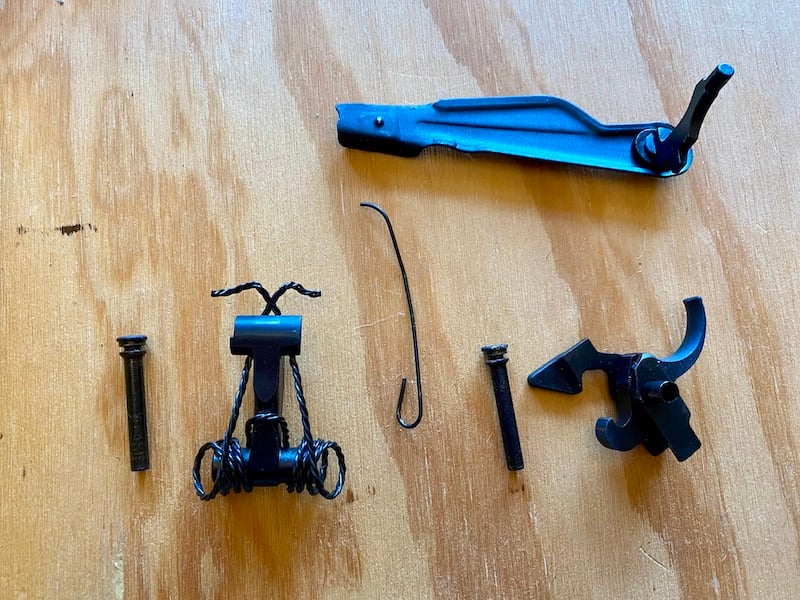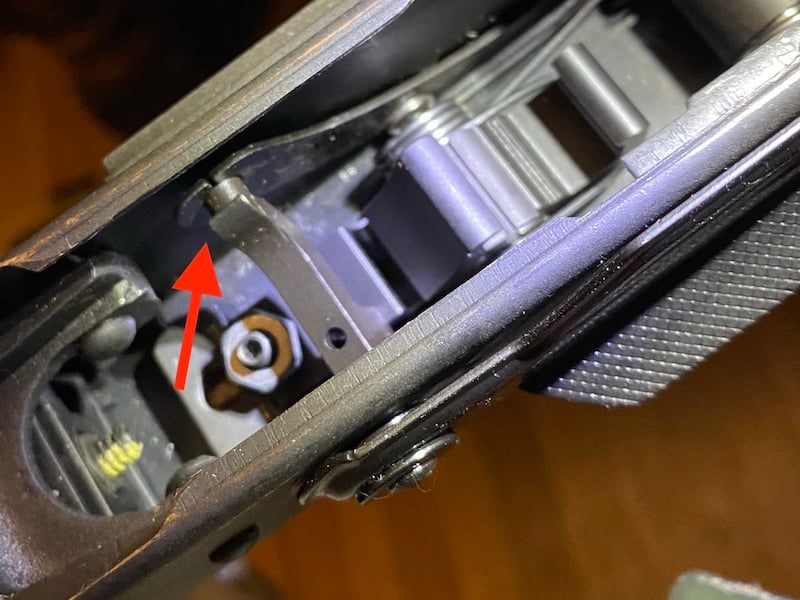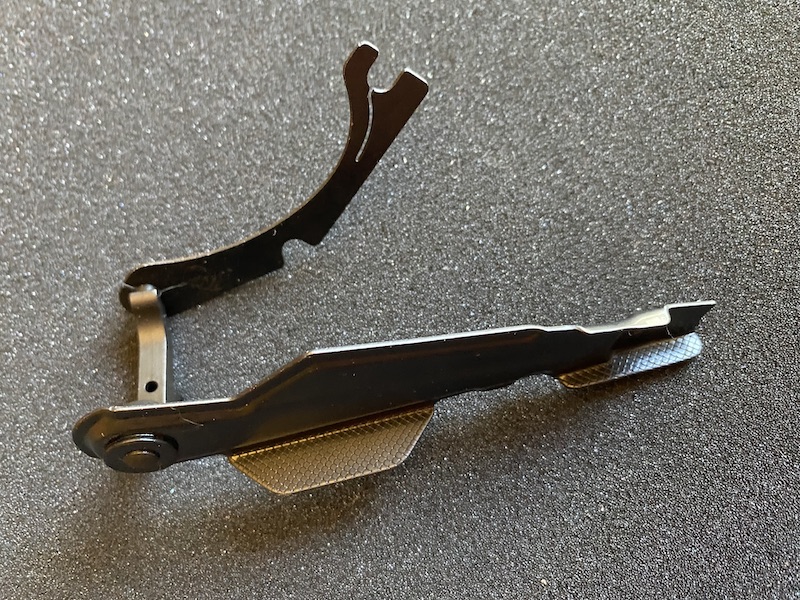If you want to feel a couple of solid hours of intense frustration, dive into some of the deeper guts of an AK-47. Despite its reputation for being built from bent sheet metal and baling wire, the mousetrap of springs and rivets that comprise the AK-47 can seriously test your patience. But here are three things that are worth the hassle.

The AK Trigger
Let’s start with the gas pedal. Seems simple enough. This is one of the worst components of most standard AK-47 builds. AK triggers have a good bit of creep, and the reset isn’t exactly short.
Run your safety checks, drop the mag, clear and clear again, then pop off the dust cover and remove the bolt and piston. At that point, you should have a clear view down into the guts of the receiver. And the trigger group and hammer should be easy to identify.
There’s a trick in here that’s important to know before you attempt to drift out pins. I’ve heard it called the shepherd’s hook—and for good reason. The skinny wire spring runs around the hammer’s pin and down under the trigger pin. Though this is a spring, it is only there to hold in the pins. There’s a channel grooved into both, and the thin steel rides in this channel, preventing the pins from backing out of the receiver. Getting this loose isn’t easy. Fine needle-nosed pliers will help. So will YouTube how-to tutorials. The hooked-in needs to come off of the front pin and pulled out towards the breech, or down through the mag well. It is dark in there, and super cramped, so be patient and good luck.
I secured the hammer springs behind the hammer, taking the pressure off the trigger, and was able to shift the bar out of its channel, toward the mid-line of the gun. With that end free, the pin for the trigger pops easily. Then the shepherd’s hook can be muscled forward out of its other channel, and it moves more freely.
Getting the trigger out, and then the hammer, is actually quite easy. Watch out for the springs on the hammer. These twisted wires can be tucked behind the hammer and crossed like an X to hold them secure, but the slightest bump will jar them free, and they whip out fast. Now that the receiver is empty, you’ll might as well give it a decent cleaning and a bit of oil. As the inside of most receivers isn’t coated or treated, you may find unexpected rust.
And now for the new trigger: the Elftmann Tactical AK-47 Single Stage, Curved Shoe Trigger.

The Elftmann AK Trigger
There’s nothing special about an AK-47 trigger. The Elftmann, though, is superb and a welcome upgrade. Replacing a standard trigger with a precision trigger is one of the easier things to do that will produce noticeable results with accuracy.
Easier, I say. While the AR-15 has really tight tolerances, and almost all of them are very similar under the hood, the AK is prone to more variation. Be patient.
The Elftmann has two springs that work together to replace the twisted original. Getting the pins to fit back in the holes is easy enough when you have no springs in there, but once you try to align a pin with the trigger and the other side of the spring and the shepherd’s hook, things can get ugly, fast. As this was my first attempt at doing this, I had more trouble than I’d like to admit. I know there is a system for getting the shepherd’s hook back in place, lacing pins through springs and such—but it is so crowded in there that I couldn’t get it.
A Quick Fix
There’s a fix for this—and one that improves the system. The retaining plate. In this case, it is an LBE Unlimited AK Retaining Plate—a simple drop-in solution that replaces the bent wire nonsense.

Re-securing the pins is incredibly easy with this thin strip of steel. It glides into the channels, locking the pins in place, and the top end is anchored by the safety. At this point, with a standard trigger, you’d be finished. As it is, there’s still work to be done to dial in the trigger. And the Elftmann has a couple of nuances that need to be taken into account.
The first is adjusting the actual trigger. The first time I put in the trigger and cocked the hammer, it locked down, and I wasn’t able to get it to release. There’s a small set-post at the back of the trigger that allows for adjustment. Loosening the retaining nut and using an Allen key to adjust this will give it the clearance needed to fall. The trick is to find the balance. Pull the trigger back and the hammer back until the hammer catches on the reset, then ease off the trigger. You want to reset to pull away, leaving the hammer cocked and the trigger ready to pull.
Once this balance is dialed in, screw down the retaining nut.
I’ve installed the new trigger. Now what? What’s the big deal?
These triggers are built on bearings. As such, the rotation is as smooth as you’d imagine. The break is clean. There’s a minuscule amount of travel needed to drop the hammer. At the bottom end of this range, you need specialized equipment to measure the weight of the pull. This one is showing just under four pounds.
That clean break and light pull, with a minuscule reset, make this a fast trigger that will take out any of the movement associated with the bad habits encouraged by stock AK-47 triggers. There’s no creep and no take-up.
Some don’t like the sharp corners on the trigger shoe. That’s a matter of personal preference. The shoe itself is half an inch wide and flat. It lends itself to a bare minimum of a finger on the trigger—and this is foreign to some AK owners who are used to hitting the trigger with the second digit on their trigger finger.

Is it worth it?
100%. Once you run a few mags through a gun with a good trigger, it is hard to go back. And I’d pick one up while you can. Elftman Tactical made a great trigger for the AK. But they have come and gone from their catalog. Why? People like me.
If you are asking now, will this fit in my AK, you are not alone. On the FAQ page on the Elftman Tactical site, they say the customer service calls about the AK triggers were too much to handle. First, we all want to know if it will fit our unique AK, then—as soon as it isn’t as easy as dropping in an AR trigger—we call back to make sure we’re not going to wreck finely tuned pieces of machinery by muscling them into our janky Kalashnikovs.
It wasn’t worth it for them. The calls were too much to handle. So, the trigger is currently not in their catalog. It is, though, here at GunMag Warehouse.

Anything else you need to consider here?
I’d say yes. Possibly. Depending on the make of your AK, two things that might get in the way: the grip and the safety. I talked about the grip above. Replacing it couldn’t be easier. Except, of course, if you were comparing the replacement to replacing the safety. Some AK trigger upgrades need a safety upgrade, too. The new trigger may not connect with the stock safety. As a bit of foreshadowing here, I’m working with a Hiperfire XAK Adjustable Safety Selector.
Replacing a safety on an AK-47 is about as easy as changing a mag. Nothing to it. With some aftermarket triggers, though, you may need to put the safety back in place before you begin dialing everything in, as adjustments to the trigger itself can block the safety from clearing.
After you’ve replaced the trigger, you need to test the gun in every way possible while it is still unloaded. I like to jar the stock hard, simulate a drop, and check the trigger’s integrity with the safety on and then off. Make sure it all works. Then, hit the range and test it all again.
The results are well worth it. For more on this project gun and external AK upgrades, check out this overview.


